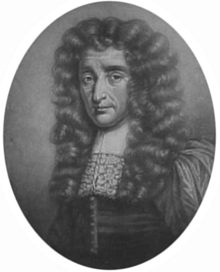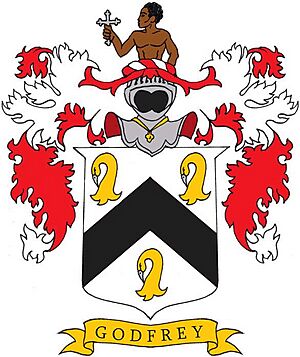Edmund Berry Godfrey facts for kids
Quick facts for kids
Edmund Godfrey
|
|
|---|---|
 |
|
| Born |
Edmund Berry Godfrey
23 December 1621 Sellindge, Kent
|
| Died | 12 October 1678 (aged 56) |
| Body discovered | Primrose Hill, London |
| Nationality | English |
| Other names | Edmundbury Godfrey |
| Education | |
| Parents |
|
Sir Edmund Berry Godfrey (23 December 1621 – 12 October 1678) was an English magistrate whose mysterious death caused anti-Catholic uproar in England. Contemporary documents also spell the name Edmundbury Godfrey.
Contents
Early life
Edmund Berry Godfrey was born in Sellindge, Kent, between Hythe and Ashford, the eleventh son of eighteen children born to Thomas Godfrey (1586–1664), a member of an old Kentish family and his second wife Sarah, née Isles. He was named after his godfathers, Edmund Harrison and Captain John Berrie (which led to the misconception that his first name was "Edmundbury"). His father had been MP for New Romney in the Short Parliament and owned Hodiford Farm. He studied at Westminster School and at Christ Church, Oxford and after entering Gray's Inn became a prominent wood and coal merchant. He became justice of the peace for Westminster and received a knighthood in September 1666 for his services during the Great Plague of 1665 when he had stayed in his post regardless of the circumstances. In 1669 Godfrey was briefly imprisoned for a few days because he had the King's physician, Sir Alexander Fraizer, arrested for owing him money. Samuel Pepys' diary of 26 May 1669 mentions that he went on hunger strike, claiming that the Judges had found for him, but the King, Charles II, had overridden them. He was held at the Porter's Lodge of Whitehall Palace.
He was in business with his brother-in-law, James Harrison. Originally their premises was in Greene's Lane (beneath present-day Charing Cross Station) but moved in 1670 to Hartshorn Lane, having use of a wharf. This is now Northumberland Avenue. His grave in St Martin-in-the-Fields has since been concreted over. After his death, his papers were retrieved from a trunk in a coffee house at Swan's Court, by Somerset House. He lived with a maid named Elizabeth Curtis and his secretary, Henry More and a housekeeper. He was considered eccentric in choosing to socialise with members of the working class instead of persons of his own class, although he did have a number of influential friends, including Gilbert Burnet and Heneage Finch, 1st Earl of Nottingham. Recently correspondence has been retrieved from Ireland detailing his relations with a faith-healer Valentine Greatrakes — the "Irish stroker". Strictly Anglican in religion, Godfrey had a number of Catholic acquaintances, including Edward Colman, Catholic secretary of the Duke of York, the future James II.
Peyton Gang
In a letter to the Secretary of State, Sir Joseph Williamson, the Lieutenant of the Tower of London named Godfrey as a member of the so-called "Peyton Gang". Sir Robert Peyton was MP for Middlesex and a prominent member of the Green Ribbon Club. This had been founded by Anthony Ashley Cooper, 1st Earl of Shaftesbury after he had become aware of the Secret Treaty of Dover in which Charles II agreed to convert himself and England to Roman Catholicism in return for money paid by the French King Louis XIV. The club, unable to confront the king directly, stirred up popular ill feeling against the Roman Catholic Church. Peyton hand-picked twelve men (including himself and Godfrey) who plotted to replace the King with a republic, nominally led by Richard Cromwell. The founding meeting of the Green Ribbon Club was in the Swan Tavern in King Street, Hammersmith. This was owned by Sir Edmund Godfrey, who left it in his will. It has been said that after Titus Oates had left his deposition with Godfrey that Godfrey warned one of the intended scapegoats, Edward Colman, who was later executed, and who was a personal friend.
Mystery
In 1678, Godfrey became involved with the schemes of Titus Oates when Oates invented the Popish Plot and began an anti-Catholic campaign. Titus Oates and Israel Tonge appeared before Godfrey and asked him to take their oath that the papers they presented as evidence were based on truth. Godfrey demanded first to know the contents of the papers and when he had received a copy on 28 September, took their depositions. He may have warned Coleman of the content of the accusations.
When Oates's accusations became known, the public became concerned. Godfrey had supposedly been concerned that he might be one of the victims of the scare, but he took no extra precautions for his own security; his conversation also became increasingly strange, with references to martyrdom and to being "knocked on the head" (the contemporary phrase for assassination).
On 12 October 1678, he left his house in the morning but did not return home. He was found dead in a ditch on Primrose Hill on 17 October.
Two committees unsuccessfully investigated the murder. They received conflicting statements about Godfrey's whereabouts before the murder. The authorities announced a reward of £500 for information about the murderers.
Miles Prance
On 21 December, Miles Prance, Catholic servant-in-ordinary to England's Catholic Queen consort, Catherine of Braganza, was arrested and taken to Newgate prison. His lodger John Wren (who was in debt to Prance) testified that he had been away for the four nights before Godfrey's body was discovered.
On 23 – 24 December, Prance announced that he had had a part in the murder but that the main instigators were three Catholic priests: Thomas Godden, head of the secular English clergy, and two Irish priests, Kelly and Fitzgerald.
Prance later recanted his confession before the king and the council and was thrown back to prison. The three men were sentenced to death 5 February 1679 and hanged at Primrose Hill. For a time this was known as "Greenberry Hill", because of the hangings of Green, Berry and Hill.
Prance's story was later discredited and he pleaded guilty to perjury. Because the three men were executed on false evidence, and historians accept their complete innocence, the murder remains officially unsolved.
Memorial
There is a tablet dedicated to his memory in the cloisters at Westminster Abbey.
See also
- List of unsolved murders in the United Kingdom]




